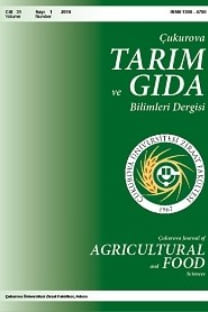Gaziantep İli Sarımsak Ekiliş Alanlarındaki Fusarium Türlerinin Teşhisi
Sarımsak (Allium sativum L.), Gaziantep ve Türkiye için önemli bir üründür. Bu çalışmanın amacı, Gaziantep ili sarımsak ekiliş alanlarında ciddi ürün kayıplarına neden olan Fusarium türlerinin belirlenmesidir. 2018 ve 2019 yılı Nisan aylarında sarımsak ekim alanlarında örnekleme yapılmıştır. Fusarium türleri, kültürel ve morfolojik özelliklerine göre Fusarium oxysporum, F. poae, F. proliferatum, F. sporotrichoioides, F. semitectum ve F. verticillioides olarak belirlendi. Patojenisite testinden, tanımlanan tüm türlerin konukçu bitki sarımsakta patojen olduğu belirlendi.
Diagnosis of Fusarium Species in Garlic Cultivation Areas in Gaziantep Province
Garlic (Allium sativum L.) is an important crop for Gaziantep and Turkey. The aim of this study was to identify the Fusarium species that caused serious crop losses in the garlic cultivation areas of Gaziantep. A sampling was conducted in garlic cultivation areas in April of 2018 and 2019. Fusarium spp. were diagnosed according to their cultural and morphological characteristics as Fusarium oxysporum, F. poae, F. proliferatum, F. sporotrichoioides, F. semitectum and F. verticillioides. From pathogenicity test, all identified species were found to be pathogenic to the host plant garlic.
___
- Atakan, A,, Erdoğan, O., Ozgonen Ozkaya, H. (2020). Evaluation of Plant Protection Practices of Garlic Growers in Gaziantep Province. Turkish Journal of Agriculture - Food Science and Technology 8(9):1942-1947.
- Atakan, A., Ozgonen Ozkaya, H. (2018). Antalya İli Karanfil Seralarında Toprak Kökenli Fungal Hastalık Etmenlerinin Yaygınlıgının Belirlenmesi. Süleyman Demirel Üniversitesi Fen Bilimleri Enstitüsü Dergisi 22(1):216-220.
- Bayraktar, H., Tekin, K., Özer, G. (2014). Soğan Üretimi ile İlişkili Farklı Fusarium Türlerinin PCR-RFLP Analizi. Anadolu Tarım Bilimleri Dergisi 29(3):194-198.
- Bayraktar, H., Dolar, F. S. (2011). Molecular Identification and Genetic Diversity of Fusarium species Associated with Onion Fields in Turkey. Journal of Phytopathology 159;28-34.
- Booth, C. (1971). The Genus Fusarium. Common wealth Mycological Institute, England.
- Dissanayake, M. L. M., Kashima, R., Tanaka, S., Ito, S. I. (2009). Pathogenic variation and molecular characterization of Fusarium species isolated from wilted Welsh onion in Japan. Journal of General Plant Pathology 75; 37–45.
- Dugan, F. M., Lupien, S. L., Hellier, B. C. (2019). Infection by Fusarium proliferatum in aerial garlic bulbils is strongly reduced compared to rates in seed cloves when both originate from infected bulbs. Crop Protection 116; 43–48.
- FAO-STAT. (2018). FAO-STAT. http://www.fao.org/faostat/en/#home
- Fisher, M. C., Henk, D. A., Briggs, C. J., Brownstein, J. S., Madoff, L. C., McCraw, S.L. and Gurr, S.J. (2012). Emerging fungal threats to animal, plant and ecosystem health. Nature 484: 186-194.
- Leslie, J. F., Summerell, B.A. (2006). The Fusarium Laboratory manual. Blackwell Publishing, USA.
- Leyronas, C., Chretien, P. L., Troulet, C., Duffaud, M., Villeneuve, F., Morris, C. E., Hunyadi, H. (2018). First report of Fusarium proliferatum causing garlic clove rot in France. Plant Disease 102(12): 2658.
- Lopez-Bellido, F. J., Lopez-Bellido, R. J., Munoz-Romero, V., Fernandez-Garcia, P., Lopez- Bellido, L. (2016). New phenological growth stages of garlic (Allium sativum). Ann. Appl. Biol. 169: 423–439.
- Mohamad Saseetharan, N. H., Zakaria, L. (2014). Occurrence of Fusarium spp. on Vegetable Crops and Assessment of Their Pathogenicity. Pertanika Journal of Tropical Agricultural Science, 37(4):445-455.
- Moharam, M. H., Farrag, E. S., Mohamed, M. D. (2013). Pathogenic fungi in garlic seed cloves and first report of Fusarium proliferatum causing cloves rot of stored bulbs in upper Egypt. Archives of Phytopathology and Plant Protection 46(17): 2096-2103.
- Mondani, L., Chiusa, G., Battilani, P. (2021 a). Chemical and biological control of Fusarium species involved in garlic dry rot at early crop stages. European Journal of Plant Pathology 1-13.
- Mondani, L., Chiusa, G., Battilani, P. (2021b). Fungi associated with garlic during the cropping season, with focus on Fusarium proliferatum and F. oxysporum. Plant health progress. https://doi.org/10.1094/PHP-06-20-0054-RS.
- Mondani, L., Chiusa, G., Pietri, A., Battilani, P. (2021c). Monitoring the incidence of dry rot caused by Fusarium proliferatum in garlic at harvest and during storage. Postharvest Biology and Technology 173: 111407.
- Oh, J.Y., Kim, K.D. (2016). Control strategies for fungal pathogens on stored onion (Allium cepa) and garlic (Allium sativum): A Review. Life Sci. Nat. Resour. Res. 24:31–40.
- Prados-Ligero, A. M., Basallote-Ureba, M. J., Lopez-Herrera, C. J., Melero-Vara. J.M. (2007). Evaluation of susceptibiliy of carnation cultivars to Fusarium wilt and determination of Fusarium oxysporum f.sp. dianthi races in Soutwest Spain. Hort Science 42(3):596-599.
- Quesada-Ocampo, L. M., Butler, S., Withers, S., Ivors, K. (2014). First report of Fusarium rot of garlic bulbs caused by Fusarium proliferatum in North Carolina. Plant disease 98(7):1009.
- Sankar, N. R. Babu, P.G. (2012). First Report of Fusarium proliferatum Causing Rot of Garlic Bulbs (Allium sativum) in India. Plant Disases 96: 290.
- Stankovic, S., Levic, J., Petrovic, T., Logrieco, A., Moretti, A. (2007). Pathogenicity and mycotoxin production by Fusarium proliferatum isolated from onion and garlic in Serbia. European Journal of Plant Pathology 118:165-172.
- Summerell, B. A., Salleh, Leslie, B. J. F. (2003). A utilitarian approach to Fusarium identification. Plant Dis 87:117–128.
- Taşkaya, B. (2003). Sarımsak. Tarımsal Ekonomi Araştırma Enstitüsü Yayını, Ankara.
- Tonti, S., Pra, M. D., Nipoti, P., Prodi, A., Alberti, I. (2012). First report of Fusarium proliferatum causing rot of stored garlic bulbs (Allium sativum L.) in Italy. J. Phytopathol. 160: 761–763.
- Townsend, G. K., Heuberger, J.W. (1943). Methods for Estimating Losses Caused by Diseases in Fungicide Experiments. Plant Disease Report. 27:340-343.
- ISSN: 2636-7874
- Başlangıç: 1973
- Yayıncı: Çukurova Üniversitesi
Sayıdaki Diğer Makaleler
Pakistan'da Nohut Germplazmında Ascochyta Blight'ın Entegre Mücadelesi
Hira NAWAZ, Sadaf NAZ, Amjad ABBAS, Hefza AFZAL, Waqas LİAQAT, Mukaddes KAYIM
Ercan YILDIZ, Mehmet YAMAN, Ahmet SÜMBÜL, Osman SÖNMEZ
Gaziantep İli Sarımsak Ekiliş Alanlarındaki Fusarium Türlerinin Teşhisi
Nuran YILDIZBAKAN, Aydin ATAKAN, Hülya ÖZGÖNEN ÖZKAYA
Filiz RANDA ZELYÜT, Ali KARANFİL, Savaş KORKMAZ
Ece Börteçine KASAPOĞLU ULUDAMAR
Fermantasyon Parametrelerinin Miscanthus’tan Elde Edilen Biyoetanol Verimine Etkisi
Kouame Fulbert OUSSOU, Mustafa Ümit ÜNAL, Aysun Şener GEDÜK
Hamdi ÖZAKTAN, Halil KIRNAK, Serhat UZUN, Hasan Ali IRIK, Mehmet ARSLAN, Mehmet YILMAZ
